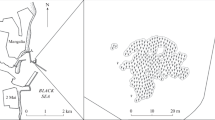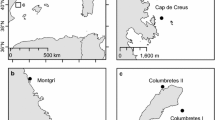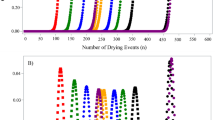Abstract
The spatio-temporal population dynamics of the subtidal snail Umbonium costatum (Kiener) in Hakodate Bay, northern Japan, are described over a 9-yr period (1982 to 1988, 1992). Annual variations in recruitment success not only caused the highly variable age structure of the population, but also affected its distribution pattern. In heavy recruitment years (1982, 1984 and 1988), location of the densest population differed from the other years, and the areas with 0 yr old individuals were larger. Every year, the distribution of 0 yr olds was mostly restricted to inshore (within 320 m from shore), while the distribution of adults (>0 yr) was mostly restricted to offshore (>320 m from shore). Such patterns may be generated by ontogenetic migration of cohorts to offshore areas. Ontogenetic migration also could have buffered the large annual variation in spat distribution and maintained the small variation in the distribution of adults. (Prince et al. 1988). Density-related migration has also been reported in Acmaea digitalis (Frank 1965), Patella cochlear (Branch 1974) and Patelloida alticostata (Black 1977).
Dense populations of the gastropod Umbonium costatum are found in some clean subtidal sandy-bottoms in Japan, e.g. inner part of Hakodate Bay. In the bay, the age structure of U. costatum revealed predominant year-classes. The 0 yr olds were restricted to the shallowest zone (<4 m depth) and most adult (<0 yr) cohorts were restricted to 6 to 7 m depths (Noda 1991a).
This paper describes the temporal variability of population structure and distributional patterns of Umbonium costatum, and examines the distribution-regulating processes.
Similar content being viewed by others
References
Berry AJ, Zamri bin O (1983) An annual cycle of recruitment, growth and production in a Malaysian population of the Trochacean gastropod Umbonium vestiarium (L.). Estuar cstl Shelf Sci 17: 357–363
Beukema JJ (1982) Annual variation in reproductive success and biomass of the major macrozoobenthic species living in a tidal flat area of the Wadden Sea. Neth J Sea Res 16: 37–45
Black R (1977) Population regulation in the intertidal limpet Patelloida alticostata (Angas, 1865). Oecologia 30: 9–22
Bowman RS, Lewis JR (1977) Annual fluctuations in the recruitment of Patella vulgata L. J mar biol Ass UK 57: 793–815
Branch GM (1974) Mechanisms reducing intraspecific competition in Patella spp.: migration, differentiation and territorial behavior. J Anim Ecol 44: 575–600
Dauvin JC, Gillet P (1991) Spatio-temporal variability in population structure of Owenia fusiformis Delle Chiaje (Annelida: Polychaeta) from the Bay of Seine (eastern English Channel). J exp mar Biol Ecol 152: 105–122
Frank PW (1965) The biodemography of the intertidal snail population. Ecology 46: 831–844
Frank PW (1975) Latitudinal variation in the life history features of the black turban snail Tegula funebralis (Prosobranchia: Trochidae). Mar Biol 31: 181–192
Fletcher WJ (1987) Interactions among subtidal Australian Sea urchins, gastropods, and algae: effects of experimental removals, Ecol Monogr 57: 89–109
Gaines SD, Brown S, Roughgarden J (1985) Spatial variation in larval concentration as a cause of spatial variation in settlement for the barnacle, Balanus glandula. Oecologia 67: 267–273
Gotelli NJ (1987) Spatial and temporal patterns of reproduction, larval settlement, and recruitment of the compound ascidian Aplidium stellatum. Mar Biol 94: 45–51
Hancock DA (1973) The relationship between stock and recruitment in exploited invertebrates. Rapp p-v Réun Cons perm int Explor Mer 164: 113–131
Hesse KO (1979) Movement and migration of the queen conch, Strombus gigas, in the Turks and Caicos Islands. Bull mar Sc 29: 303–311
Hughes TP (1990) Recruitment limitation, mortality, and population regulation in open system: a case study. Ecology 71: 12–20
Kalyanasundaram N, Ganti SS, Karande AA (1972) The habitat and habitat selection by Umbonium vestiarium L. Proc Indian natn Sci Acad 38: 275–287
Keough MJ (1983) Patterns of recruitment of sessile invertebrates in two subtidal habitats. J exp mar Biol Ecol 66: 213–245
Keough MJ, Downes BJ (1982) Recruitment of marine invertebrates: the role of active larval choices and early mortality. Oecologia 54: 348–352
Lewis JR, Bowman RS, Kendall MA, Williamson P (1982) Some geographical components in population dynamics: possibilities and realities in some littoral species. Neth J Sea Res 16: 18–28
McGrorty S, Clarke RT, Reading CJ, Goss-Custard JD (1990) Population dynamics of the mussel Mytilus edulis: density changes and regulation of the population of the Exe estuary, Devon. Mar Ecol Prog Ser 67: 157–169
McShane PE, Smith MG (1991) Recruitment variation in sympatric populations of Haliotis rubra (Mollusca: Gastropoda) in southeast Australian waters. Mar Ecol Prog Ser 73: 203–210
Moore HB (1938) The biology of Purpura lapillus. III. Life history of relation to environmental factors. J mar biol Ass UK 23: 67–89
Nakaoka M (1993) Yearly variation in recruitment and its effect on population dynamics in Yoldia notabilis (Mollusca: Bivalvia), analyzed using projection matrix model. Res Popul Ecol 35: 199–213
Noda T (1991a) Population structure and distribution of the sand snail, Umbonium costatum (Kiener) in Hakodate Bay. Bull Fac Fish Hokkaido Univ 42: 126–135
Noda T (1991b) Shell growth of the sand snail, Umbonium costatum (Kiener) in Hakodate Bay. Bull Fac Fish Hokkaido Univ 42: 115–125
Noda T, Nakao S, Goshima S (1995) Life history of temperate subtidal gastropod Umbonium costatum. Mar Biol 122: 73–78
Peterson CH, Summerson HC (1992) Basin-scale coherence of population dynamics of an exploited marine invertebrate, the bay scallop: implications of recruitment limitation. Mar Ecol Prog Ser 90: 257–272
Phillips BF (1969) The population ecology of the whelk Dicathais aegrota in western Australia. Aust J mar Freshwat Res 20: 225–265
Prince JD, Sellers TL, Ford WB, Talbot SR (1988) Recruitment, growth, mortality and population structure in a southern Australian population of Haliotis rubra (Mollusca: Gastropoda). Mar Biol 100: 75–82
Stoner AW, (1989) Winter mass migration of juvenile queen conch Strombus gigas and their influence on the benthic environment. Mar Ecol Prog Ser 56: 99–104
Sutherland JP, Karlson R (1977) Development and stability of the fouling community at Beaufort, North Carolina. Ecol Monogr 47: 425–446
Wada K, Fukao R, Kuwamura T, Nishida M, Yanagisawa Y (1983) Distribution and growth of the gastropod Strombus luhuanus at Shirahama, Japan. Publs Seto mar biol Lab 28: 417–432
Weins JA (1977) On competition and variable environments. Am Scient 65: 590–597
Woodin SA (1976) Adult-larval interactions in dense infaunal assemblages: patterns of abundance. J mar Res 34: 25–41
Yoshioka PM (1982) Role of planktonic and benthic factors in the population dynamics of bryozoan Membranipora membranacea. Ecology 63: 457–468
Yoshioka PM (1986) Chaos and recruitment in the bryozoan, Membranipora membranacea. Bull mar Sci 39: 408–417
Author information
Authors and Affiliations
Additional information
Communicated by T. Ikeda, Hiroshima
Rights and permissions
About this article
Cite this article
Noda, T., Nakao, S. Spatio-temporal population dynamics of the sand snail Umbonium costatum: importance of ontogenetic migration and annual recruitment variability. Marine Biology 123, 815–820 (1995). https://doi.org/10.1007/BF00349125
Received:
Accepted:
Issue Date:
DOI: https://doi.org/10.1007/BF00349125




